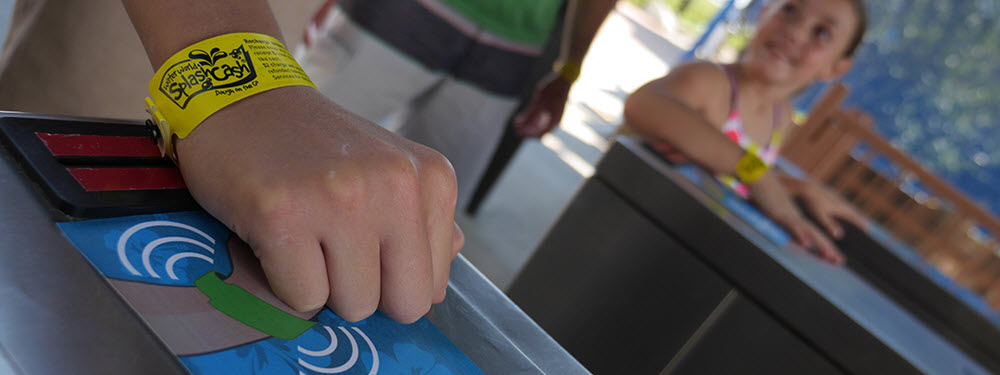How Wristbands Improve Swimming Safety and Save Lives

The Drowning Problem
Water safety programs are very important to implement due to the fact that drowning is the second leading cause of injury death in children ages 1-14 in the United States. On average, two children die from unintentional drowning every day, according to the Center for Disease Control (CDC).
Two of the biggest risk factors for drowning are lack of swimming ability and lack of close supervision. The risk of drowning is preventable in almost all scenarios, especially if children are supervised around bodies of water. Where it gets tricky to supervise closely is when you have a lot of kids in one place, such as a city pool, park, or camp. When children outnumber adults, supervision is more difficult
If you manage a pool facility for a city, camp, or park, it's your responsibility to set up and administer swimmer safety programs for children. When thinking about preventative action you can take, it's worth considering how wristbands can help you ensure safety of kids while at the pool.
Wristbands are the Perfect Solution to Drowning
Developing a program to identify and group children participating in aquatic activities at public pools, churches, summer camps, etc. is essential. Wristbands are a perfect solution. Waterproof plastic or vinyl wristbands are durable, non-transferable, and highly visible. This makes them perfect to be seen under water and last for an entire week of summer camp. Another option are Tyvek wristbands if you need something for a short-term use, such as a day at the city pool or theme park.
Here are 3 benefits of implementing wristbands for your swimmer safety program:
Wristbands Can Save Lives
Did you know that you can use different color-coded wristbands for your swimmers to segment them into age groups and/or their varying levels of swimming ability? Color-coding can help lifeguards and other staff pick out the kids who need more supervision and keep a closer eye on those at higher risk of drowning.
The most commonly used colors for swimming wristbands are green, yellow, and red. You can think of these colors as how they are used on traffic signals. Green means "go," yellow means "caution," and red means "stop." You can segment children by a combination of their age and swimming ability. You can give older children and strong swimmers a green wristband,and younger children and weaker swimmers a red wristband. With color-coded wristbands, you can limit access to different parts of the pool or water park. For example, children with green wristbands can jump off the diving board while swimmers with red wristbands have to stay in the shallow end.
Peace of Mind for Kids and Parents
Not only do wristbands help lifeguards do their job more effectively but there's a psychological benefit to them as well. If you have an organized system in place to keep kids safe while swimming, it will help both the kids and their parents feel more at ease. Parents especially like to know that the safety of their children is top priority to the people responsible for supervising them.
If a drowning were to happen during your program, it could severely damage your reputation and put your program in a bad light. Sometimes, you can't control certain mistakes or tragedies, but you should do everything in your power to prevent something like this from happening. Implementing a wristband safety program for your water activities ensures that your program will be seen in a positive light by the community.
Advertising on Millions of Wrists
An additional benefit of using wristbands that you might not have thought about is the advertising component. Not only can wristbands help save lives but they can also help you share your brand with all of your swimmers and their parents.
Did you know you can customize your wristbands with the logo of your summer camp or church program? Not only will kids wear them while swimming but they often wear vinyl wristbands or plastic wristbands long after they leave the pool. This is great advertising to help you grow your organization and it can lead to important conversations about your safety program and how other organizations can implement something similar.
Conclusion
As you can see, assigning different colored wristbands for the range of ages, swimming levels, and access can help lifeguards and staff better supervise children while swimming. If you manage a city pool facility, summer camp, or church program, you should consider the benefits of implementing wristbands for child pool safety.
Tyvek, vinyl, and plastic wristbands are all good options for you to consider. Tyvek wristbands tend to be the most cost effective, but they typically last only 1 day. If you want something more durable that will last longer, you should consider plastic or vinyl wristbands.
PDC offers the largest selection of stock and custom wristband materials, colors, and styles to meet your needs. If you're interested in adding text or a logo to your wristbands, our easy-to-use wristband customizer is the perfect option for implementing your very own pool safety program.


 FREE SHIPPING ON ORDERS ABOVE $99
FREE SHIPPING ON ORDERS ABOVE $99
 SAFE AND SECURE
SAFE AND SECURE





